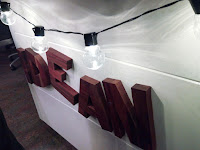 |
| Sunset in Helsinki |
After enjoying the sun in the afternoon with a nice run, the Interaction-Community already started coming together for the first evening event at the IDEAN office. They really have nice slogan...
"Life is too short for crappy UX!"IDEAN and IBM invited for a get-together and Douglas Powel (Design Principal at IBM Design) presented how they are currently facilitating their design process.
 |
| Get-together at IDEAN office |
Design is not something new for IBM - it started in the mid of the 20th century.
"Good design is good business." (Quote from 1966)And todays philosophy of IBM is:
"The technology we use at work should be as delightful, intuitive and efficient as the techology we use the rest of our life."The tactical formula to reach this goal is focusing on three parts: people, places and processes.
PEOPLE
IBM hired a lot of Designers - they have a 3 months' program (like a boot camp) to give the new employees the chance to "understand" IBM with all the related aspects. They have now 700 designers and are hiring more - 2/3 directly from the university.PLACES
The designers will work in Studios - the workplace needs to be flexible (moveable whiteboards) and collaborative, with a lot of space to be creative.PROCESSES
IBM created an IBM design language, which is available since early 2015 - it includes resource for vision, motion and interaction design. It's available at IBM.com/design.A process resource is the IBM design thinking: it's design thinking but focusing on distributed teams and high speed (constant movement) - so the focus is speed & scale.
The IBM design thinking focuses on user outcomes, multidisciplinary team and restless reinvention (iterations) - the team need to "move" always; stagnation is the worst.
So Douglas Powell presented a good overview of how IBM is facilitating the design process and there are some interesting aspects - but I'm still curious if they are able to make the huge amount of "new" designer really productive.

So this evening was already a nice start with interesting discussions and I'm already looking forward to the first day of the conference tomorrow.
Thx IDEAN (@Idean) once again for hosting this nice evening.











